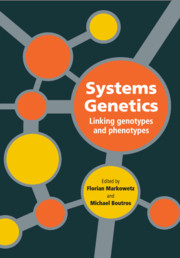Book contents
- Frontmatter
- Contents
- List of contributors
- 1 An introduction to systems genetics
- 2 Computational paradigms for analyzing genetic interaction networks
- 3 Mapping genetic interactions across many phenotypes in metazoan cells
- 4 Genetic interactions and network reliability
- 5 Synthetic lethality and chemoresistance in cancer
- 6 Joining the dots: network analysis of gene perturbation data
- 7 High-content screening in infectious diseases: new drugs against bugs
- 8 Inferring genetic architecture from systems genetics studies
- 9 Bayesian inference for model selection: an application to aberrant signalling pathways in chronic myeloid leukaemia
- 10 Dynamic network models of protein complexes
- 11 Phenotype state spaces and strategies for exploring them
- 12 Automated behavioural fingerprinting of Caenorhabditis elegans mutants
- Index
- Plate Section
- References
11 - Phenotype state spaces and strategies for exploring them
Published online by Cambridge University Press: 05 July 2015
- Frontmatter
- Contents
- List of contributors
- 1 An introduction to systems genetics
- 2 Computational paradigms for analyzing genetic interaction networks
- 3 Mapping genetic interactions across many phenotypes in metazoan cells
- 4 Genetic interactions and network reliability
- 5 Synthetic lethality and chemoresistance in cancer
- 6 Joining the dots: network analysis of gene perturbation data
- 7 High-content screening in infectious diseases: new drugs against bugs
- 8 Inferring genetic architecture from systems genetics studies
- 9 Bayesian inference for model selection: an application to aberrant signalling pathways in chronic myeloid leukaemia
- 10 Dynamic network models of protein complexes
- 11 Phenotype state spaces and strategies for exploring them
- 12 Automated behavioural fingerprinting of Caenorhabditis elegans mutants
- Index
- Plate Section
- References
Summary
Introduction
Proteins and their interactions determine how cells behave. Genes are the blueprints for protein synthesis; their activation or suppression determines the absence or presence of a protein which in turn can give rise to further activation or suppression of other genes and proteins. This chemical chain reaction usually involves positive and negative feedback loops and is subjected to stochastic noise and the influence of environmental factors. Moreover, epistasis – the cancellation or modification of a gene's contribution to the phenotype by other genes – is generally the rule rather than the exception in genetics.
Despite all these factors, amazingly robust cell behavior is apparent in many biological systems although it is difficult to be modeled and/or predicted. Building the topology and quantifying the direct and indirect cause–effect (stimulus, expression, activation, behavior) relationships of the reactions leading to the phenotypes – in general, genetic regulatory networks (GRN) – is challenging in at least three ways.
Firstly, how are these relationships described? Traditionally, mathematical models are expressed in terms of transfer functions relating inputs to outputs expressed as a composition of differential equations with a time dimension. We argue though that the cellular signaling networks are probabilistic in nature and that diffusion-based models remain challenging due to lack of knowledge of essential system parameters, such as rate constants. Most importantly, treating intracellular protein and gene interactions as in-vitro chemical reactions might not be safe because the usual assumption of diffusion dynamics namely that of the free movement of a sufficiently large number of molecules is usually the exception rather than the rule due to the very small number of reactant molecules in highly confined and crowded space. Moreover, the concentration of a protein is highly dependent on sub cellular localization and thus the picture of the cell as a homogeneous mix container is simply wrong. Of even more profound impact, many signaling systems are centered on or around scaffolding proteins mimicking solid-state chemical environments and have little or no resemblance to diffusion limited systems.
Information
- Type
- Chapter
- Information
- Systems GeneticsLinking Genotypes and Phenotypes, pp. 214 - 233Publisher: Cambridge University PressPrint publication year: 2015
